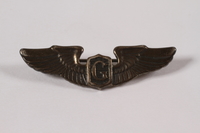Overview
- Brief Narrative
- US Army corporal shoulder chevron issued to William G. Allan, 2nd Lieutenant, 99th Infantry Division, United States Army. The 99th Infantry was deployed overseas in September 1944, and fought its way across Europe. After the Battle of the Bulge, it was one of the first divisions to cross into Germany in March 1945. The 99th Division is an officially recognized concentration camp liberating unit. In early May, it liberated several Dachau subcamps, including a concentration camp linked to the Muhldorf complex. The division was near Munich when the war ended on May 7 and returned to the US in September.
- Date
-
received:
approximately 1944
- Credit Line
- United States Holocaust Memorial Museum Collection, Gift of Tara Allan Stewart
- Contributor
-
Subject:
William G. Allan
- Biography
-
William G. Allan served in the United States Army, 99th Infantry Division, during World War II. He achieved the rank of 2nd Lieutenant. The 99th Infantry was deployed overseas in September 1944, and fought its way across Europe. After the Battle of the Bulge, it was one of the first divisions to cross into Germany in March 1945. The 99th Division is an officially recognized concentration camp liberating unit. In early May, it liberated several Dachau subcamps, including a concentration camp linked to the Muhldorf complex. The division was near Munich when the war ended on May 7 and returned to the US in September. William and his wife Sarah had three children. William died in 2005, age 84 years.
Physical Details
- Classification
-
Military Insignia
- Category
-
Badges
- Object Type
-
Chevrons (lcsh)
- Physical Description
- Chevron or an upward pointing v-shaped dark blue felt shoulder patch with 2 vertical machine embroidered olive drab v-shaped stripes (chevrons). The reverse is reinforced with white thread.
- Dimensions
- overall: Height: 3.125 inches (7.938 cm) | Width: 3.000 inches (7.62 cm)
- Materials
- overall : felt, thread
Rights & Restrictions
- Conditions on Access
- No restrictions on access
- Conditions on Use
- No restrictions on use
Keywords & Subjects
Administrative Notes
- Legal Status
- Permanent Collection
- Provenance
- The US Army patch was donated to the United States Holocaust Memorial Museum in 2006 by Tara Allan Stewart, the daughter of William G. Allan.
- Funding Note
- The cataloging of this artifact has been supported by a grant from the Conference on Jewish Material Claims Against Germany.
- Record last modified:
- 2024-10-03 12:21:23
- This page:
- https://collections.ushmm.org/search/catalog/irn54277
Download & Licensing
In-Person Research
- By Appointment
- Request 21 Days in Advance of Visit
- Plan a Research Visit
- Request to See This Object
Contact Us
Also in William G. Allan collection
The collection consists of military insignia and photographs relating to the experiences of William G. Allan as a 2nd Lieutenant in the United States Army, 99th Infantry Brigade, during his service in Germany during World War II.
Date: 1943-1945

US glider pilot sterling silver pin acquired by a US soldier
Object
US Army glider pilot wingshaped pin with the letter G acquired by William G. Allan, 2nd Lieutenant, 99th Infantry Division, United States Army. Gliders were towed near battle areas then released to navigate their landing. The 99th Infantry was deployed overseas in September 1944, and fought its way across Europe. After the Battle of the Bulge, it was one of the first divisions to cross into Germany in March 1945. The 99th Division is an officially recognized concentration camp liberating unit. In early May, it liberated several Dachau subcamps, including a concentration camp linked to the Muhldorf complex. The division was near Munich when the war ended on May 7 and returned to the US in September.
William G. Allan photographs
Document
Contains 24 photographs documenting the Ohrdruf concentration camp shortly after liberation.
German Army eagle breast patch acquired by a US soldier
Object
German army pattern breast eagle acquired by William G. Allan, 2nd Lieutenant, 99th Infantry Division, United States Army. The patch, in the shape of the Nazi national emblem, an eagle grasping a swastika, would be sewn to the uniform above the left breast. The US 99th Infantry was deployed overseas in September 1944, and fought its way across Europe. After the Battle of the Bulge, it was one of the first divisions to cross into Germany in March 1945. The 99th Division is an officially recognized concentration camp liberating unit. In early May, his unit liberated several Dachau subcamps, including a concentration camp linked to the Muhldorf complex. The division was near Munich when the war ended on May 7 and returned to the US in September.
US Officer Candidate School patch acquired by a US soldier
Object
US Officer Candidate School badge issued to William G. Allan, 2nd Lieutenant, 99th Infantry Division, United States Army. The 99th Infantry was deployed overseas in September 1944, and fought its way across Europe. After the Battle of the Bulge, it was one of the first divisions to cross into Germany in March 1945. The 99th Division is an officially recognized concentration camp liberating unit. In early May, it liberated several Dachau subcamps, including a concentration camp linked to the Muhldorf complex. The division was near Munich when the war ended on May 7 and returned to the US in September.



